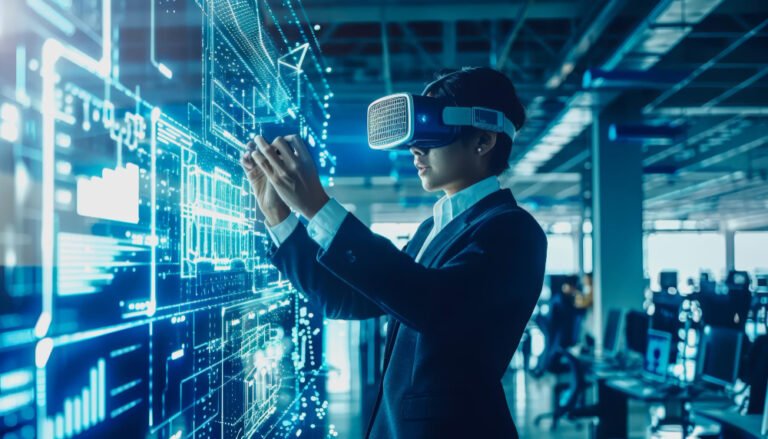Reimagining Car Prototyping and Marketing with Real-Time 3D in Unreal Engine
The automotive industry has witnessed a significant shift from traditional design methodologies to advanced digital techniques. Vehicle design software has become an essential tool, enabling designers to create, iterate, and visualize car models with remarkable precision and speed. Unreal Engine stands out in this landscape, providing a robust platform for real-time visualization and interaction.
Unreal Engine stands out as a game-changer, offering real-time 3D capabilities that enhance automotive simulation. This technology allows for rapid iterations and precise visualizations of 3D automotive modelling.
Transition from Traditional to Digital
The transition from traditional sketching and clay modeling to digital design tools has been gradual yet revolutionary. Traditional methods, while still respected for their hands-on approach, often lag in efficiency and adaptability. Digital design software, including Unreal Engine, allows for seamless modifications, immediate feedback, and integration with other digital tools. This evolution not only speeds up the design process but also enables the exploration of more complex design ideas that would be cumbersome with traditional methods.
The Rise of Real-Time 3D in Car Prototyping
Unreal Engine’s real-time 3D capabilities allow designers to render high-fidelity models in an interactive environment. This shift from static images to dynamic, interactive experiences enables designers to simulate real-world conditions, assess design aesthetics, and test functionality more effectively. The ability to manipulate 3D models in real-time enhances the prototyping process, reducing development time and costs.
Interactive Prototyping
Interactive prototyping in Unreal Engine brings a new dimension to the design table. Designers can now engage with their models in ways previously unimaginable, testing different scenarios and observing how design changes affect the vehicle in real-time. This interactivity is crucial for identifying potential issues early in the development process, thus saving time and resources by minimizing the need for physical prototypes.
Cost Efficiency and Time Reduction
The financial implications of real-time 3D prototyping are significant. By reducing the number of physical prototypes needed, companies save on material costs and labor. Moreover, the rapid iteration process enabled by real-time 3D tools accelerates the timeline from concept to production, allowing companies to bring their vehicles to market faster than ever before. This efficiency can be a crucial competitive advantage in the fast-paced automotive industry.
Enhancing Automotive Simulation
Automotive simulation has become a cornerstone of modern vehicle design. Unreal Engine’s advanced simulation capabilities provide designers with the tools to create realistic driving scenarios, test vehicle performance, and analyze safety features in a controlled virtual environment. By leveraging Unreal Engine, automotive companies can simulate various driving conditions, optimize vehicle dynamics, and ensure regulatory compliance before physical prototyping.
Simulating Real-World Conditions
Simulating real-world conditions in a virtual environment offers unparalleled insights into vehicle performance. Designers can test how a vehicle behaves under different weather conditions, road types, and traffic scenarios. This comprehensive testing ensures that vehicles are not only aesthetically pleasing but also functional and safe, meeting high standards before they ever hit the road.
Safety and Compliance Testing
Safety is paramount in automotive design, and Unreal Engine facilitates rigorous testing of safety features. By simulating crash tests and other safety scenarios, designers can evaluate how well a vehicle protects its occupants in various situations. Compliance with regulatory standards can be assured through detailed simulations, reducing the risk of costly recalls or redesigns after production.
3D Automotive Modeling: A New Frontier
The integration of 3D automotive modeling in Unreal Engine offers a new dimension to vehicle design. Designers can create detailed and lifelike models that accurately represent the final product. This level of detail not only enhances the design process but also improves communication between designers, engineers, and stakeholders.
The Role of 3D Modeling Firms
3D modeling companies play a crucial role in the automotive industry by providing expertise and resources to create high-quality models. With Unreal Engine, these companies can deliver immersive experiences that showcase the intricacies of car designs, from the exterior bodywork to the interior layout. This immersive visualization aids in decision-making, ensuring that the final product aligns with the initial design vision.
Collaboration and Communication
The collaboration between designers, engineers, and stakeholders is critical in the automotive design process. High-quality 3D models serve as a common language that all parties can understand, making it easier to convey design intentions and receive meaningful feedback. Unreal Engine’s capabilities facilitate this communication by providing a detailed and interactive view of the vehicle, ensuring that everyone involved has a clear understanding of the project at every stage.
Enhancing Design Accuracy
Accuracy in design is paramount, and 3D modeling in Unreal Engine enhances this aspect significantly. The precision with which models can be crafted ensures that what is seen in the virtual environment is a true representation of the final product. This accuracy reduces the risk of discrepancies between the design and the manufactured vehicle, ensuring a smoother transition from the digital model to the physical product.
Transforming Car Marketing with Unreal Engine
Unreal Engine’s capabilities extend beyond design and prototyping, offering innovative solutions for car marketing. The traditional approach of showcasing cars through static images and videos is being replaced by interactive and immersive experiences.
Engaging Consumers with Virtual Showrooms
Virtual showrooms powered by Unreal Engine allow potential buyers to explore vehicles in a realistic and engaging manner. Customers can interact with the car’s features, customize options, and experience the vehicle in a virtual setting. This level of interactivity enhances the buying experience, providing consumers with a deeper understanding of the product.
Personalized Buying Experience
The personalized nature of virtual showrooms means that customers can tailor their exploration to suit their preferences. Whether it’s choosing a specific color, testing out different interior options, or even visualizing the car in various environments, the experience becomes uniquely theirs. This personalization not only makes the process more enjoyable but also helps customers make informed decisions based on their individual needs and desires.
Broader Reach and Accessibility
Virtual showrooms break down geographical barriers, allowing consumers from around the world to experience a vehicle without needing to visit a physical dealership. This accessibility broadens a company’s reach, opening up new markets and demographics that may have been previously out of reach. Moreover, virtual showrooms are available 24/7, providing potential buyers the convenience of exploring at their own pace and time.
Leveraging Interactive Marketing Campaigns
Interactive marketing campaigns utilizing Unreal Engine’s real-time 3D capabilities can captivate audiences and drive engagement. By creating immersive experiences that allow users to interact with car models, companies can showcase their products’ unique features and benefits. This approach not only attracts potential buyers but also fosters brand loyalty and enhances customer satisfaction.
Engaging Content Creation
Creating engaging content is crucial in today’s saturated market, and Unreal Engine provides the tools to do just that. With real-time 3D, marketing teams can create captivating visual narratives that highlight the vehicle’s features in a way static images cannot. These interactive experiences can be shared across various platforms, ensuring that the brand’s message reaches a wide audience and resonates with potential customers.
Building Long-Term Relationships
Interactive campaigns are not just about immediate sales; they’re about building lasting relationships with consumers. By offering an engaging and memorable experience, companies can create emotional connections with their audience. These connections foster brand loyalty, encouraging repeat business and positive word-of-mouth referrals, which are invaluable in maintaining a competitive edge.
Case Studies: Success Stories in Automotive Real-Time 3D
by Lovie Tey (https://unsplash.com/@lovietey)
Several automotive companies have successfully integrated Unreal Engine into their design and marketing strategies, reaping significant benefits.
BMW: Revolutionizing Design and Marketing
BMW has embraced Unreal Engine to transform its design and marketing processes. By utilizing real-time 3D rendering, BMW has streamlined its design workflow, reduced prototyping costs, and improved collaboration among teams. Additionally, BMW’s virtual showrooms have enhanced customer engagement, providing an immersive platform for consumers to explore their vehicles.
Streamlined Design Workflow
BMW’s implementation of Unreal Engine has significantly streamlined its design workflow. The ability to quickly iterate and visualize changes in real-time has improved the efficiency of their design process. This streamlined workflow not only reduces the time from concept to production but also improves the accuracy of the final product, ensuring that it meets BMW’s high standards of quality and innovation.
Enhanced Customer Engagement
BMW’s virtual showrooms have set a new standard for customer engagement. These immersive platforms allow customers to explore every aspect of a vehicle in a virtual environment, from the exterior design to the interior features. This enhanced engagement provides customers with a deeper understanding of the product, increasing their confidence in their purchasing decisions and strengthening their connection to the BMW brand.
Audi: Pioneering Virtual Reality Experiences
Audi has been at the forefront of leveraging Unreal Engine for virtual reality experiences. Through immersive VR showrooms, Audi allows customers to experience their vehicles in a virtual environment, offering a unique perspective on design and functionality. This innovative approach has strengthened Audi’s brand presence and attracted tech-savvy consumers.
Virtual Reality as a Differentiator
Audi’s use of virtual reality sets it apart from competitors by providing a truly unique customer experience. The immersive nature of VR allows customers to interact with vehicles in ways that traditional marketing cannot match, offering a comprehensive view of the vehicle’s design and features. This differentiation is key in attracting tech-savvy consumers who value innovation and cutting-edge technology in their purchasing decisions.
Strengthening Brand Presence
By pioneering virtual reality experiences, Audi has strengthened its brand presence in the automotive market. These innovative showrooms not only attract new customers but also reinforce the brand’s commitment to innovation and quality. This strengthened presence is invaluable in a competitive market, ensuring that Audi remains top-of-mind for consumers considering a new vehicle purchase.
The Future of Car Prototyping and Marketing
The integration of real-time 3D in Unreal Engine marks a pivotal moment in the automotive industry. As technology continues to advance, the potential for innovation in car prototyping and marketing is boundless. Unreal Engine’s capabilities empower designers to push the boundaries of creativity, optimize design processes, and deliver exceptional customer experiences.
Embracing a New Era of Automotive Innovation
As automotive companies continue to embrace real-time 3D technology, the industry is poised for a new era of innovation. The ability to visualize, simulate, and market vehicles in an interactive and immersive manner will redefine how cars are designed, developed, and sold. By harnessing the power of Unreal Engine, automotive companies can stay ahead of the curve, delivering cutting-edge products that captivate and engage consumers.
Redefining Automotive Design Standards
The adoption of real-time 3D tools like Unreal Engine is redefining the standards of automotive design. Designers are no longer limited by the constraints of traditional methods, allowing for more creative and innovative approaches to vehicle development. This redefinition of standards will lead to the creation of vehicles that are not only functional but also groundbreaking in their design and technology.
Driving Forward with Consumer-Centric Strategies
The shift towards real-time 3D technology is also driving a more consumer-centric approach in the automotive industry. By offering interactive and personalized experiences, companies can better meet the needs and desires of their customers. This focus on the consumer ensures that the vehicles developed are not only technologically advanced but also aligned with the preferences and expectations of the market.
In conclusion, the integration of real-time 3D in Unreal Engine is revolutionizing car prototyping and marketing. From enhancing vehicle design software to transforming automotive simulation and 3D modeling, Unreal Engine offers a comprehensive solution for the automotive industry’s evolving needs. By embracing this technology, automotive companies can unlock new possibilities, drive innovation, and create compelling experiences for consumers.






